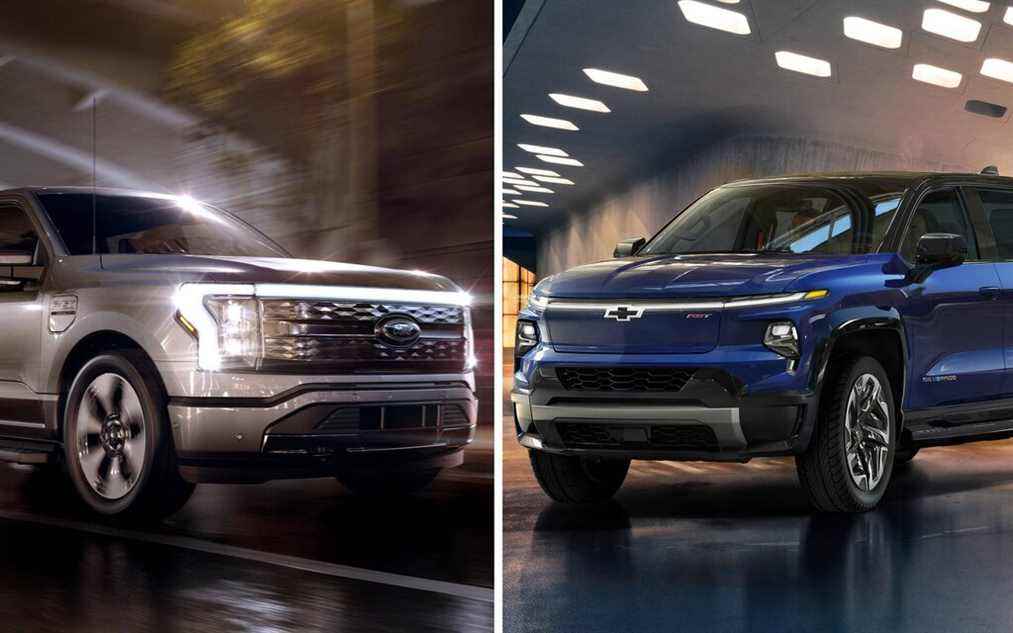Competition promises to be fierce in the electric truck segment, particularly with the Ford F-150 Lightning and soon, the Chevrolet Silverado EV.
To help you see more clearly, we have broken down the specifications of these two models. Here’s what came out of it.
Range: Chevrolet Silverado EV advantage
At Chevrolet, the WT and RST versions offer the ability to travel up to 640 kilometers on a full charge. The Silverado EV comes standard with 350 kW fast charging, which allows it to add 160 kilometers of range in ten minutes.
The Ford F-150 Lightning offers a 370 kilometer variant and another with an extended range of 483 kilometres. Using a 150 kW terminal, it is possible to go for 87 kilometers in ten minutes (extended autonomy version). Moreover, the battery can fill up from 15% to 80% in 41 minutes.
Since the Silverado EV can travel a greater distance and has a faster recharge, it wins the day here.
Photo: General Motors
Performance: equality
The Silverado EV WT develops 510 horsepower and 615 lb-ft of torque. As for the RST, the cavalry goes up to 660 horsepower and the torque increases to 780 lb-ft.
This latest version rivals the unique version of the F-150 Lightning, which produces 563 horsepower and 775 lb-ft of torque. Why? Because the sprint from 0 to 60 mph (0 to 97 km/h) is done in 4.5 seconds for both trucks. The version equipped with the regular battery offers 426 horsepower.
Practical side: equality
The WT and RST versions of the Silverado EV can pull loads of up to 8,000 lbs and 10,000 lbs respectively. The crate can hold 1,200 lb or 1,300 lb weights depending on the variant selected.
Chevrolet will later introduce a commercial version which, equipped with the maximum towing package, will be able to tow loads weighing up to 20,000 lb (9,027 kg).
As for the Ford F-150 Lightning, the range-extended XLT and Lariat trims equipped with the Tow Package will be able to tow up to 10,000 lbs. Payload goes up to 2,000 lbs.
In addition, the Silverado EV and the F-150 Lightning are both equipped with a trunk located in the front. In the case of the Ford, the volume amounts to 400 liters. This data is not available for the Chevrolet. The RST version of the bow tie brand has directional wheels at the rear.

Photo: General Motors
Technological integration: equality
The Lariat and Platinum versions of the Ford F-150 Lightning use the SYNC 4 system for infotainment, via a 15.5-inch screen. It features Apple CarPlay, Android Auto and Amazon Alexa apps, all wireless. Digital instrumentation is offered with a 12-inch monitor.
As for the Silverado EV, its infotainment system uses a 17-inch screen. This will be the very first application of Ultifi, a new Linux-based software platform. Moreover, the dashboard measures 11 inches and the head-up display, 14 inches.
Safety: equality
Safety-wise, the F-150 Lightning and Silverado EV use similar technologies. Both have access to semi-autonomous driving (Blue Cruise and Super Cruise respectively), standard driver aids and home power functionality.

Photo: Ford
Price: to be determined…
The Silverado EV WT starts at $54,748, while the option-packed RST version costs $122,248 (prices include $2,300 freight). Other versions will be announced later, such as the Trail Boss.
At Ford, the entry-level F-150 Lightning retails for $58,000 (MSRP), while the XLT costs $68,000. Available in spring 2022, the Ford F-150 Lightning will be offered in four versions.
Although the Silverado EV has a lower base price than the F-150 Lightning, we are comparing 2024 Chevrolet and 2022 Ford models. Therefore, it is impossible to determine a winner in this regard.
Guarantee: equality
The base, powertrain and component warranties for hybrid/electric vehicles are identical:
- Basic: 3 years/60,000 km
- Powertrain: 5 years/100,000 km
- Electrical components: 8 years/160,000 km
Puncture protection differs between the two manufacturers. Ford offers 5 years/unlimited mileage, while Chevrolet offers 6 years/160,000 km.
